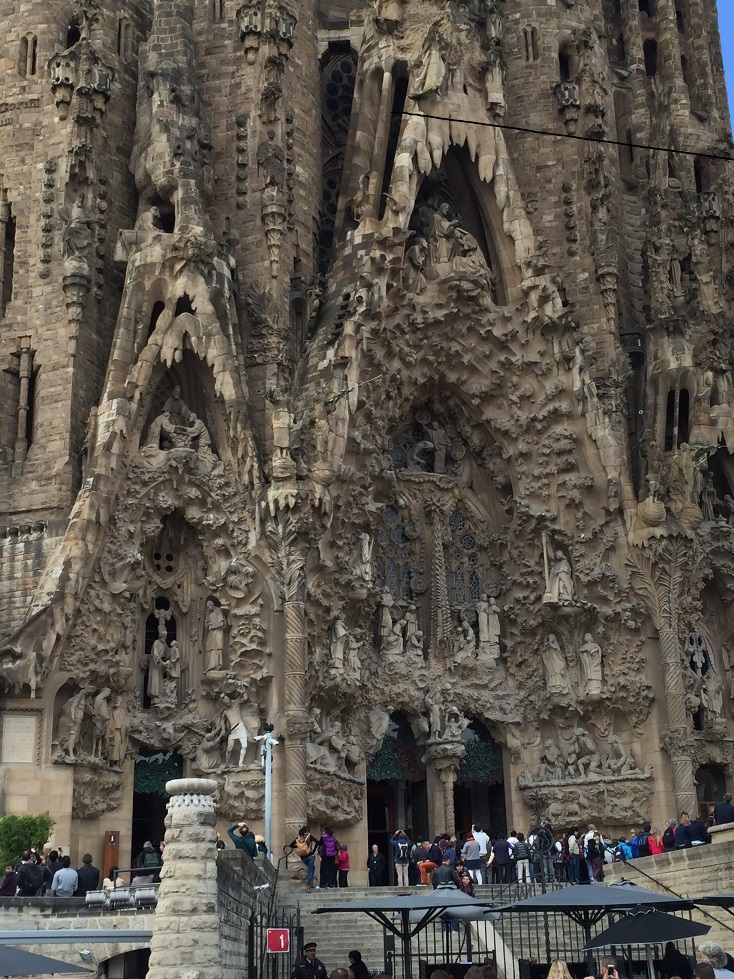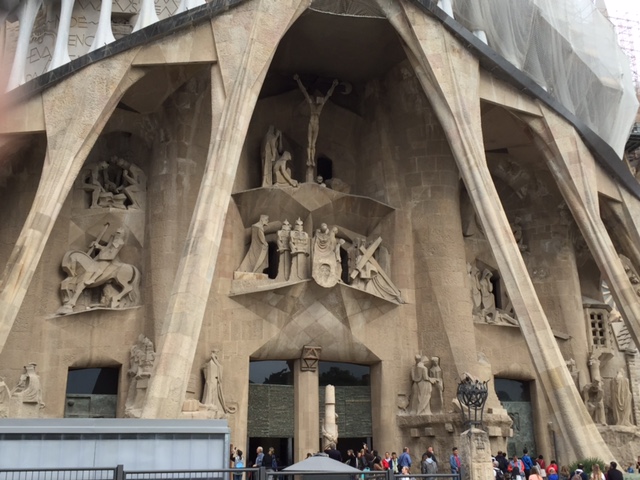Theodore Prescott: The Sagrada Familia
PERMANENCE AND CHANGE AT SAGRADA FAMILIA
By Theodore Prescott
Antonio Gaudi’s church of Sagrada Familia – fully known as the Basilica and Expiatory Church of the Holy Family – is the most popular attraction in Barcelona. Roughly 3,000,000 people a year visit the church, which is sometimes erroneously referred to as a cathedral. (The church is not where Barcelona’s bishop has his ‘cathedra’ or Bishop’s chair.) When it is completed the central tower, one of eighteen spires, will rise above the crossing about 550 feet or 170 meters, making it the tallest church in the world.
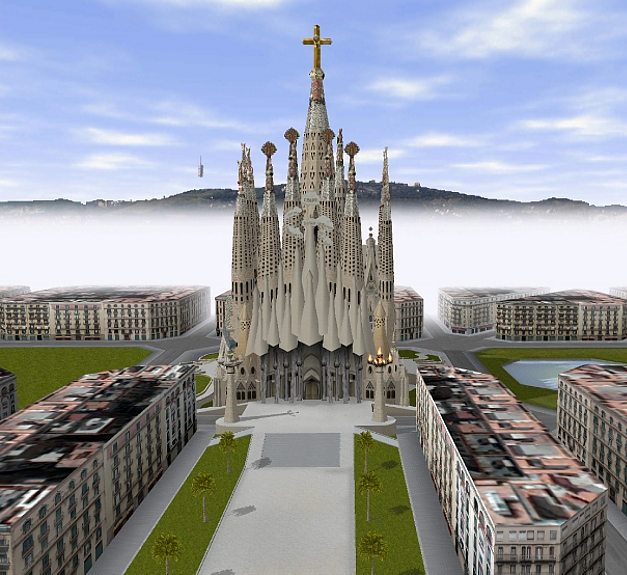
Rooted in the great cathedral tradition, Sagrada Familia is characterized by dizzying structural innovation and formal, ornamental, and symbolic exuberance. It is by turns fantastic, playful, severe, and cerebral. The church is widely judged to be the vision of a genius, but has generated substantial controversy and criticism from both aesthetic and political perspectives. Aesthetically many find the building to be excessive, and some find it incoherent. Its parts don't seem to share a common language. Politically the church has been seen as an expression of Catalonian separatism or of an authoritarian Catholicism that figured prominently in 19th and 20th century Spanish politics. In 1936, 10 years after Gaudi's death and at the beginning of the civil war, a few Republican revolutionaries broke into his studio at the church site and destroyed models and drawings. This made all future interpretations of Gaudi’s intentions open to dispute, due to incomplete information.
Sagrada Familia was begun in 1882, as the private endeavor of a publisher who wanted to honor the Holy Family. Within a year the initial architect quit and the 31-year old Gaudi became responsible for its design and construction. While he built on its Gothic plan, the church he designed over the next 40 years defies easy stylistic categorization. Sagrada Familia was the culmination of a sparkling career of impressive commissions, and several of his buildings are now listed as world heritage sites. Around the time Gaudi became the chief architect for Sagrada Familia, he began reading the Bible and attending mass daily.
He had had a spiritual awakening which was initiated by his friendship with the Bishop of Astorga. Perhaps a serious illness of 1911deepened his spiritual focus, because after 1914 he took no other work and devoted himself to the construction of the church. At the time of his death in 1926 he was living an impoverished existence on its site, wearing clothing that was sometimes literally pinned together. He would occasionally publicly beg to raise funds for it. At his death the church was about 25% complete, with the Crypt, the Apse, and the majority of the Nativity Facade completed. Building was fitful to the 1960’s, but picked up in the last four decades of the 20th century. Today construction is constant, funded by entrance fees and donations. The hope is that the entire church will be complete by 2026, the 100th anniversary of Gaudi's death.
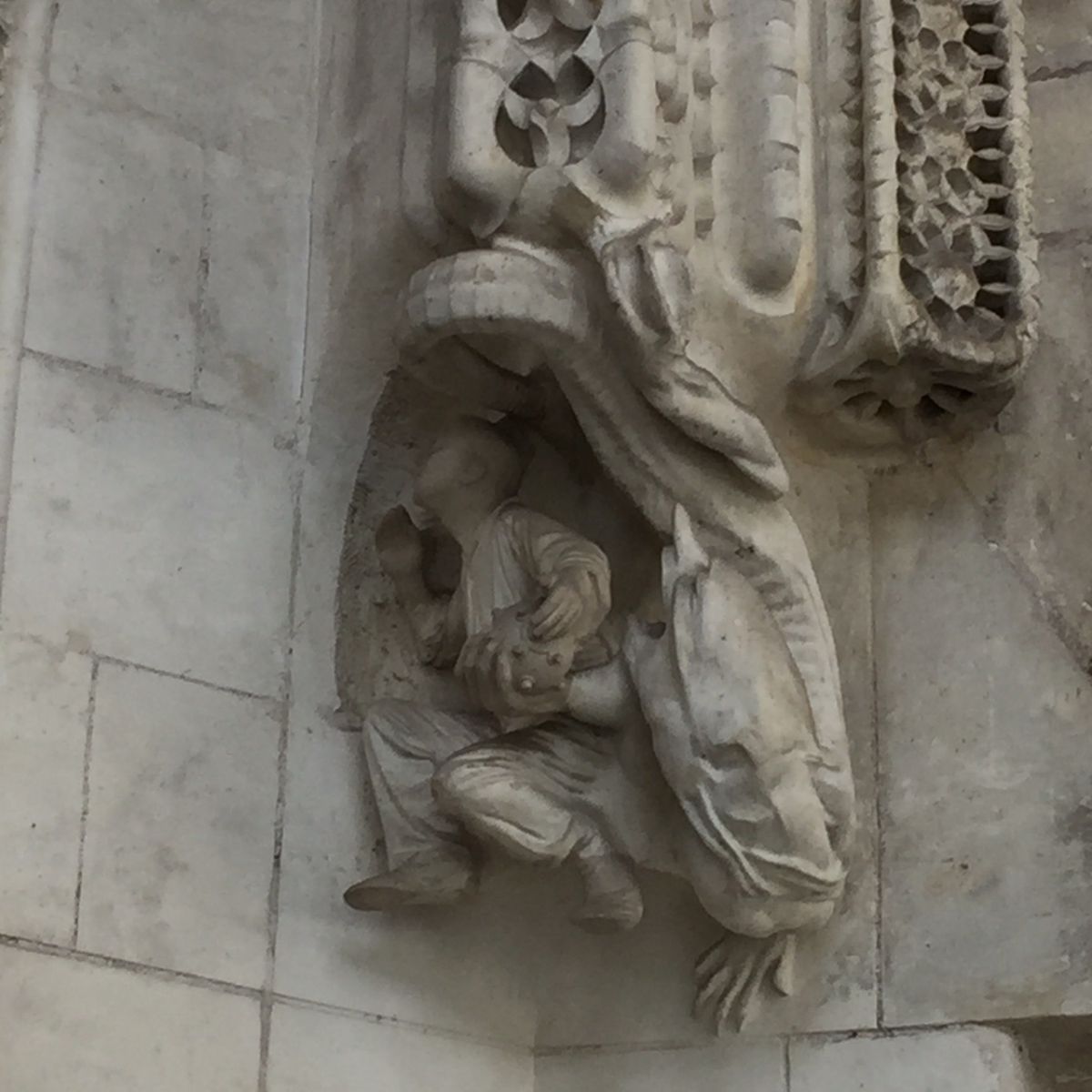
Sagrada Familia is a visual encyclopedia of Christian narrative and Catholic doctrine as Gaudi sought to embody the faith through images, symbols, and expressive forms. He was inventive as well as traditional in his treatment of iconography and Christian conventions. Thus the oversized snails used for some gargoyles were not fantastic creatures, but were carved from casts of small snails found at the site. The two central columns of the first facade to be constructed, the Nativity Facade, rest on tortoises, evidently adapted from Chinese symbols of stability and permanence. But two large chameleons roaming at the sides of the facade suggest mutability and change. In the nearby Rosary Chapel, sculptural representations of the temptations have stimulated visitors’ comments. People often mention the representation of violence, where a serpent with a fiendish head hands a man an Orsini bomb, the type used by anarchists to bomb the Barcelona opera house in 1893.
Surely the Nativity Facade itself, with its deep arches, superabundance of garlands, vegetation, and descending wavelets of stone is unique in church imagery. It effectively dissolves the perception of structural support into an overwhelming, undulating flood of symbol and decorative detail. Amidst this cornucopia of fertility the narratives surrounding Christ's birth are related in sculptural tableaux with multiple figures – some of which Gaudi personally worked on. The forms are naturalistic and often references living models. A young draughtsman working on church plans posed for the trumpeting angels on the facade, and the donkey seen in The Flight into Egypt tableaux was carefully chosen by Gaudi, and cast from life as a model for the stone carvers.
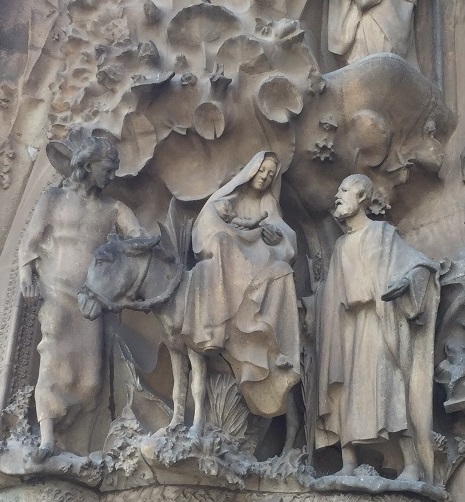
Walking from the Nativity Facade around to the Passion Facade can be a dislocating experience. Construction on this facade, based on one sketch Gaudi made when he was ill in 1911, began in the 1950’s. Gaudi had thought about starting the church by building the Passion Facade first, but believed its stark expressive nature might alienate people. He said he wanted the facade to ‘... give the idea that sacrifice is a bloody business.’ The 18 bone-like forms above the angled porch roof were meant to suggest the rib cage of someone suffocating by crucifixion. But for many, the spare, expressionist language of the facade seemed antithetical to Gaudi’s existing work, and a manifesto was circulated in the architectural community demanding that construction stop. The signatories included the architects Le Corbusier, Mies van der Rohe, and Walter Gropius.
The sculptures for the Passion Facade were designed and executed by the Catalan sculptor Josep Subirachs. The last of the roughly100 sculptures for it was installed in 2005. Subirachs' sculptural forms are minimal, sharp-edged, expressively exaggerated, and sometimes border on caricature. These too have provoked strong criticism, but one of his stipulations in taking the commission was that he would be stylistically independent of Gaudi. Like Gaudi, Subirachs was iconographically innovative. Thus a 5 meter tall faceless Christ hangs suspended from the cross bar of a horizontal steel cross. We see Christ’s face on Veronica's veil below. Subirachs (d. 2014) and the church were resolute in defending his work. The church argued that ‘... it does not make sense to judge it solely from the artistic point of view. Religious and artistic dimensions are of equal importance.’
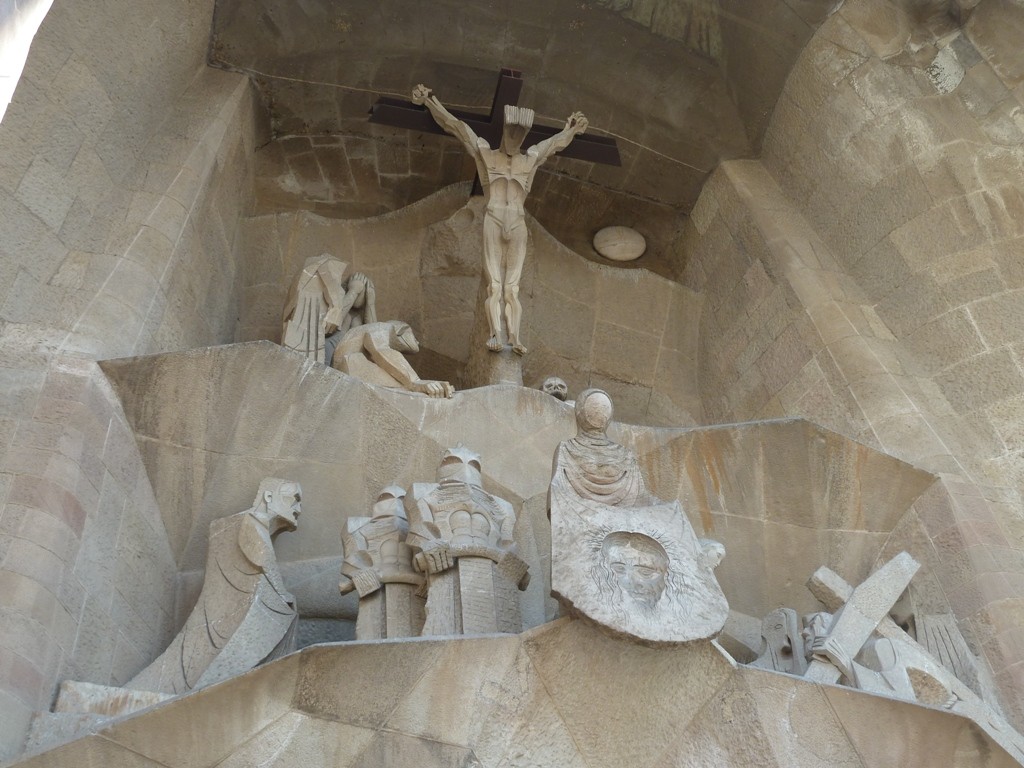
The final facade, the Glory Facade, is under construction now. It is the largest, and will be the main entrance to the church, with a total of seven doors. It too will have its own singular language. Models depict a kind of suspended canopy of inter-linked and inverted cones above the doors. According to literature sold at the church, these may be seen as clouds and as tears. Tears are appropriate for a church that is a temple for atonement. Above this canopy are spires and four taller towers representing the four evangelists. Evidently Gaudi intended this entrance to symbolize the last things, Death, Judgement, the Descent into Hell, and finally Glory.
The ascending clusters of Sagrada Familia’s distinctive towers create a singular profile against Barcelona’s skyline. Yet a close experience of the church, as one walks its accessible perimeter, is not singular. Words, texts, symbols, images, varieties of materials, stylistic pluralism and formal fragmentation all vie for attention, and create a dissonance reminiscent of post modernism. While the church is not finished, I suspect that sense of dissonance will remain. Of course, stylistic changes during a building’s construction are not unique. A famous example is Chartres, where almost 400 years separates the building of the two different towers framing the western entrance. Many churches of old attracted crowds of people too and fulfilled social functions beyond personal devotion or corporate worship. What is unique about Sagrada Familia is that its construction coincides with the decline of Christendom and perhaps unwittingly indicates that. Institutionally the church is rooted in Christendom, but its material form emerged during a period of increasing public skepticism about religion. Thus Sagrada Familia’s ‘religious dimensions’ may falter when they are pitted against the artistic judgements of the public, who appear to have more concerns about the church’s aesthetics than about its religious beliefs.
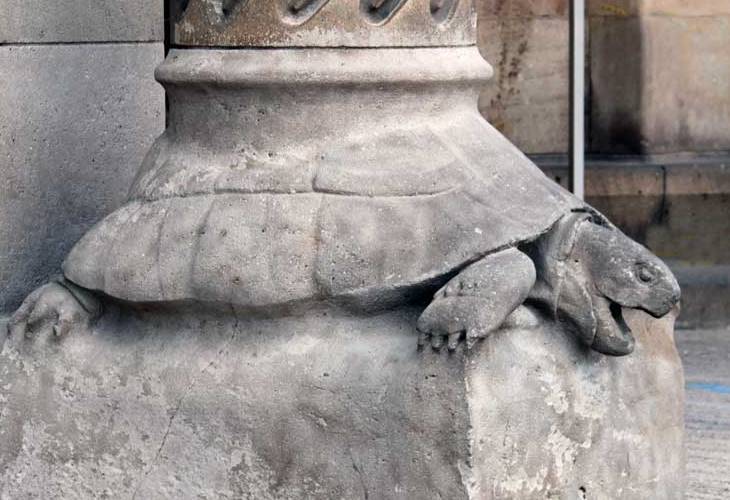 |
.jpg) |
How prescient then of Gaudi to put those turtles and chameleons at the Nativity entrance. They frame our experience. While the chameleons are more easily noticed, it is the less visible turtles that support the whole edifice. And we have to look harder now to find the ‘the permanent things’ the Christian faith proclaims exist beneath all our cultural flux. But apparently Gaudi was not too worried about change. He was quite clear that the church would be modified by his successors, as he was just one servant in a line of servants, all working for a Client who ‘is not in a hurry’. Hopefully many of those 3,000,000 yearly visitors will see this as they try to take everything in.
*******
Theodore Prescott is a sculptor and writer who lives near Harrisburg PA. He has exhibited in the United States and Europe, completed several public commissions, and has work in public and private collections. In 1980 Prescott began the art major at Messiah College in Grantham, PA. He chaired the art program for a decade, and was the recipient of two successive terms as a Distinguished Professor of Art. He is an Emeritus Professor of Art at the college. Prescott was one of the founders of the American organization CIVA (Christians in the Visual Arts), served as its third president, and edited its triennial publication for more than a decade. His articles on art have appeared in several publications, including American Arts Quarterly, Image, and The New Criterion. He has edited one book on contemporary figurative art and written several catalog essays for group and solo exhibitions by contemporary artists. His work and a list of publications can be seen at www.tedprescottsculpture.com.
More:
28 March 2024 / Stations of the Cross in HornseaMatthew Askey's most recent project is a set of ‘Stations of the Cross’ for St Nicholas Church, Hornsea. This is a site-specific commission of paintings that link each Station to a part of the town.
Read more...28 February 2024 / Book review Abundantly More
01 February 2024 / James Tughan: CONTACT
13 October 2023 / David Miller Interview
“Form welcomes the formless home”
Jonathan Evens interviews David Miller on his work and the “interrelation, symbiosis and overlap” between writing and visual art
Read more...07 August 2023 / Ethnoarts Scripture Engagement
by Scott Rayl
Ethnoarts are artistic ‘languages’ that are unique to a particular community. They can help strengthen cultural and Christian identity.
Read more...12 June 2023 / Georges Rouault and André Girard
by Jonathan Evens
Rouault and Girard: Crucifixion and Resurrection, Penitence and Life Anew
Read more...28 April 2023 / Josh Tiessen: Vanitas + Viriditas
28 April - 26 May, New York gallery Rehs Contemporary will present Josh Tiessen: Vanitas and Viriditas.
Read more...10 April 2023 / Images for God the Father
by Marleen Hengelaar-Rookmaaker
How can we ever comprehend God the Father with our small human intellects? How can we ever get to know Him and learn to live with Him?
Read more...16 February 2023 / Ervin Bossanyi: A vision for unity and harmony
by Jonathan Evens
Bossanyi joined the large number of émigré artists arriving in Britain after WW II, many of whom were Jewish and explored spirituality within their work.
Read more...06 January 2023 / The Creative Process
by Colin Black
Creative journeys are full of mishaps, accidents, and wrong turnings.
Read more...01 December 2022 / ArtWay newsletter 2022
Artway will be continued by the Kirby Laing Centre for Public Theology from the beginning of 2024.
Read more...20 October 2022 / Kuyper, the Aesthetic Sphere, and Art
After three centuries of silence about art in Reformed theological circles in the Netherlands, suddenly there was Abraham Kuyper, whose great merit it was that he once again drew attention to art.
Read more...06 September 2022 / On the Street: The work of JR
by Betty Spackman
Through the project in Tehachapi JR wanted to "give voice to prisoners" and humanize their environment.
Read more...04 August 2022 / Joseph Beuys: A Spiritual German Artist
Is there a thread that connects the multifaceted work of this artist? My hypothesis is that Beuys’ spirituality is what drives his diverse work.
Read more...01 June 2022 / Interview with Belinda Scarlett
BELINDA SCARLETT, theatre costume and set designer and ecclesiastical textile artist
Interview by JONATHAN EVENS
Read more...21 April 2022 / Betty Spackman: A Creature Chronicle
When I consider the heavens, the moon and the stars that you have made, what are mere mortals that you are mindful of them… Psalm 8
Read more...08 April 2022 / Historical Models for Crosses and Crucifixes Today
All crosses and crucifixes symbolise joy and salvation. But formally there are two different types: the victorious and the suffering crucifix.
Read more...16 March 2022 / Three artworks by Walter Hayn
by Gert Swart
These three artworks must have turned Walter Hayn inside out, being so powerfully revealing.
Read more...22 February 2022 / Abstract Expressionism
by Nigel Halliday
It is worth the while to remember the deep seriousness of these artists – even if their suggested answers can look sadly thin.
Read more...07 January 2022 / Artist duo Gardner & Gardner
by Elizabeth Kwant
During COP26 artist duo Gardner & Gardner installed their work I will learn to sit with you and I will learn to listen in Glasgow Cathedral.
Read more...09 December 2021 / ArtWay Newsletter and List of Books 2021
Marleen Hengelaar-Rookmaaker intends to phase out her participation in the day to day oversight of the ArtWay website over the course of the coming new year.
Read more...03 November 2021 / The Seven Works of Mercy in Art
by Marleen Hengelaar-Rookmaaker
This overview will show that these artworks from different ages mirror the theological ideas and the charitable works of their times.
Read more...06 October 2021 / Disciplining our eyes with holy images
by Victoria Emily Jones
Images tend to work a subtle magic on us, especially after years of constant exposure.
Read more...24 August 2021 / On the Gifts of Street Art
by Jason Goroncy
These works represent an act of reclaiming public space for citizens rather than merely consumers.
Read more...27 July 2021 / Russia’s 1st Biennale of Christ-centered Art
An opportunity of dialogue between the church and contemporary art
by Viktor Barashkov
Read more...30 June 2021 / Jacques and Raïssa Maritain among the Artists
by David Lyle Jeffrey
About the influence of Jacques and Raïssa Maritain on Rouault, Chagall and Arcabas.
Read more...13 May 2021 / GOD IS...
Chaiya Art Awards 2021 Exhibition: “God Is . . .”
by Victoria Emily Jones
Read more...21 April 2021 / Photographing Religious Practice
by Jonathan Evens
The increasing prevalence of photographic series and books exploring aspects of religious practice gives witness to the return of religion in the arts.
Read more...23 March 2021 / Constanza López Schlichting: Via Crucis
Perhaps what may be different from other Stations of the Cross is that it responds to a totally free expression and each station is a painting in itself.
Read more...10 February 2021 / Gert Swart: Four Cruciforms
In a post-Christian era, contemporary Christian artists have to find new ways of evoking the power of the cross.
Read more...08 January 2021 / Reflecting on a Gauguin Masterpiece
by Alan Wilson
An artist's reflection on Impressionism, Cezanne, Van Gogh and especially Gauguin's Vision after the Sermon.
Read more...11 December 2020 / ArtWay Newsletter 2020
What makes the ArtWay platform so special is its worldwide scope thanks to its multilingual character. There are ArtWay visitors in all countries on this planet.
Read more...27 October 2020 / Art Pilgrimage
A Research Project on Art Stations of the Cross
by Lieke Wijnia
Read more...18 September 2020 / Interview with Peter Koenig
by Jonathan Evens
Koenig's practice demonstrates that the way to avoid blandness in religious art is immersion in Scripture.
Read more...17 August 2020 / BOOK REVIEW BY HEINRICH BALZ
How Other Cultures See the Bible
Christian Weber, Wie andere Kulturen die Bibel sehen. Ein Praxisbuch mit 70 Kunstwerken aus 33 Ländern.
Read more...17 July 2020 / The Calling Window by Sophie Hacker
by Jonathan Evens
In 2018 British artist Sophie Hacker was approached to design a window for Romsey Abbey to celebrate the bicentenary of the birth of Florence Nightingale.
Read more...12 June 2020 / A little leaven leavens the whole lump
From South Africa
Ydi Carstens reports on the group show ‘Unleavened’ which was opened in Stellenbosch shortly before the Covid-19 lock-down.
Read more...14 May 2020 / Jazz, Blues, and Spirituals
Republished:
Hans Rookmaaker, Jazz, Blues, and Spirituals. The Origins and Spirituality of Black Music in the United States.
Reviewed by Jonathan Evens
Read more...17 April 2020 / Andy Warhol: Catholicism, Work, Faith And Legacy
by Jonathan Evens
While Warhol’s engagement with faith was complex it touched something which was fundamental, not superficial.
Read more...25 March 2020 / Sacred Geometry in Christian Art
by Sophie Hacker
This blog unravels aspects of sacred geometry and how it has inspired art and architecture for millennia.
Read more...22 February 2020 / Between East and West
By Kaori Homma
Being in this limbo between day and night makes me question, “Where does the east end and the west start?”
Read more...15 February 2020 / Imagination at Play
by Marianne Lettieri
To deny ourselves time to laugh, be with family and friends, and fuel our passions, we get caught in what Cameron calls the “treadmill of virtuous production.”
Read more...07 December 2019 / ArtWay Newsletter 2019
An update by our editor-in-chief
and
the ArtWay List of Books 2019
16 November 2019 / Scottish Miracles and Parables Exhibition
Alan Wilson: "Can there be a renewal of Christian tradition in Scottish art, where ambitious artists create from a heartfelt faith, committed to their Lord and saviour as well as their craft?"
Read more...23 September 2019 / Dal Schindell Tribute
While Dal’s ads and sense of humour became the stuff of legends, it was his influence on the arts at Regent College in Vancouver, Canada that may be his biggest legacy.
Read more...04 September 2019 / The Aesthetics of John Calvin
Calvin stated that 'the faithful see sparks of God's glory, as it were, glittering in every created thing. The world was no doubt made, that it might be the theater of divine glory.'
Read more...31 July 2019 / The Legend of the Artist
by Beat Rink
The image of the 'divine' artist becomes so dominant that artists take their orientation from it and lead their lives accordingly.
Read more...02 July 2019 / Quotes by Tim Keller
Many “Christian art” productions are in reality just ways of pulling artists out of the world and into the Christian subculture.
Read more...08 June 2019 / The Chaiya Art Awards
by Jonathan Evens
The Chaiya Art Awards 2018 proved hugely popular, with over 450 entries and more than 2,700 exhibition visitors.
Read more...29 May 2019 / Art Stations of the Cross: Reflections
by Lieke Wynia
In its engagement with both Biblical and contemporary forms of suffering, the exhibition addressed complex topical issues without losing a sense of hope out of sight.
Read more...03 May 2019 / Marianne Lettieri: Relics Reborn
Items that show the patina of time and reveal the wear and tear of human interaction are carriers of personal and collective history.
Read more...27 April 2019 / Franciscan and Dominican Arts of Devotion
by John Skillen
This manner of prayer stirs up devotion, the soul stirring the body, and the body stirring the soul.
Read more...13 March 2019 / Makoto Fujimura and the Culture Care Movement
by Victoria Emily Jones
Culture care is a generative approach to culture that brings bouquets of flowers into a culture bereft of beauty.
Read more...08 January 2019 / Building a Portfolio of People
by Marianne Lettieri
Besides hard work in the studio, networking may be the single most important skill for a sustainable art practice.
Read more...01 December 2018 / ArtWay Newsletter December 2018
ArtWay has Special Plans for 2019!
After London, Washington D.C. and New York the city of Amsterdam in the Netherlands is now the anticipated location for a prominent art exhibition with the title Art Stations of the Cross.
Read more...11 October 2018 / The Life, Art and Legacy of Charles Eamer Kempe
Book Review by Jonathan Evens
The significance and spirituality of the work is made clear in ways which counteract the stereotype of mass production of a static style.
Read more...13 September 2018 / A Visit to the Studio of Georges Rouault
by Jim Alimena
Everything we saw and learned reinforced my picture of a great man of faith and a great artist.
Read more...09 August 2018 / With Opened Eyes: Representational Art
by Ydi Coetsee
How do we respond to the ‘lost innocence’ of representational art?
Read more...13 July 2018 / True Spirituality in the Arts
by Edith Reitsema
Living in Christ should lead us away from living with a segregated view of life, having a sacred-secular split.
Read more...17 May 2018 / Beholding Christ in African American Art
Book review by Victoria Emily Jones
One of the hallmarks of Beholding Christ is the diversity of styles, media, and denominational affiliations represented.
Read more...23 April 2018 / Short Introduction to Hans Rookmaaker
by Marleen Hengelaar-Rookmaaker
On the occasion of the establishment of the Rookmaaker Jazz Scholarship at Covenant College, Chattanooga, Tennessee, 12 March 2018
Read more...04 April 2018 / International Art Residency in India
Art for Change, a New Delhi based arts organization with a vision to see art shape society with beauty and truth, will be running its 6th annual International Artist Residency in November 2018.
Read more...15 March 2018 / The Stations of the Cross at Blackburn Cathedral
by Penny Warden
Perhaps the central challenge for the artist in imaging the body of Christ is the problem of representing the dual natures of the doctrine of the incarnation.
Read more...23 February 2018 / Between the Shadow and the Light
By Rachel Hostetter Smith
In June 2013 a group of twenty North American and African artists from six African countries met for two weeks of intensive engagement with South Africa.
Read more...30 January 2018 / Sacred Geometry in Christian Art
by Sophie Hacker
This blog unravels aspects of sacred geometry and how it has inspired art and architecture for millennia.
Read more...01 January 2018 / Jonathan Evens writes about Central Saint Martins
Why would Central Saint Martins, a world-famous arts and design college and part of University of the Arts London, choose to show work by its graduates in a church?
Read more...06 December 2017 / ArtWay Newsletter December, 2017
ArtWay's Chairman Wim Eikelboom: "The visual arts cultivate a fresh and renewed view of deeply entrenched values. That is why ArtWay is happy to provide an online platform for art old and new."
Read more...14 November 2017 / The Moral Imagination: Art and Peacebuilding
In the context of conflict transformation the key purpose of creative expression is to provide a venue for people to tell their stories, and for their stories to be heard.
Read more...24 October 2017 / Bruce Herman: Ut pictura poesis?
For the last couple hundred of years the arts have largely been in "experimentation mode"—moving away from the humble business of craft and service toward ideas, issues, and theory.
Read more...04 October 2017 / David Jeffrey: Art and Understanding Scripture
The purpose of In the Beauty of Holiness: Art and the Bible in Western Culture is to help deepen the reader’s understanding of the magnificence of the Bible as a source for European art.
Read more...08 September 2017 / David Taylor: The Aesthetics of John Calvin
Calvin stated that 'the faithful see sparks of God's glory, as it were, glittering in every created thing. The world was no doubt made, that it might be the theater of divine glory.'
Read more...23 August 2017 / Reconstructed by Anikó Ouweneel
A much talked-about exposition in the NoordBrabants Museum in The Netherlands showed works by modern and contemporary Dutch artists inspired by traditional Catholic statues of Christ and the saints.
Read more...04 July 2017 / Pilgrimage to Venice – The Venice Biennale 2017
When I start to look at the art works, I notice a strange rift between this pleasant environment and the angst and political engagement present in the works of the artists.
Read more...24 June 2017 / Collecting as a Calling
After many years of compiling a collection of religious art, I have come to realize that collecting is a calling. I feel strongly that our collection has real value and that it is a valuable ministry.
Read more...02 June 2017 / I Believe in Contemporary Art
By Alastair Gordon
In recent years there has been a growing interest in questions of religion in contemporary art. Is it just a passing fad or signs of renewed faith in art?
Read more...04 April 2017 / Stations of the Cross - Washington, DC 2017
by Aaron Rosen
We realized that the Stations needed to speak to the acute anxiety facing so many minorities in today’s America and beyond.
Read more...07 March 2017 / Socially Engaged Art
A discussion starter by Adrienne Dengerink Chaplin
Growing dissatisfaction with an out-of-touch, elite and market driven art world has led artists to turn to socially engaged art.
Read more...01 February 2017 / Theodore Prescott: Inside Sagrada Familia
The columns resemble the trunks of trees. Gaudi conceived of the whole interior as a forest, where the nave ceiling would invoke the image of an arboreal canopy.
Read more...03 January 2017 / Steve Scott tells about his trips to Bali
In the Balinese shadow play the puppet master pulls from a repertoire of traditional tales and retells them with an emphasis on contemporary moral and spiritual lessons.
Read more...09 December 2016 / Newsletter ArtWay December 2016
Like an imitation of a good thing past, these days of darkness surely will not last. Jesus was here and he is coming again, to lead us to the festival of friends.
Read more...01 November 2016 / LAbri for Beginners
What is the role of the Christian artist? Is it not to ‘re-transcendentalise’ the transcendent, to discern what is good in culture, and to subvert what is not with a prophetic voice?
Read more...30 September 2016 / Book Review by Jonathan Evens
Jonathan Koestlé-Cate, Art and the Church: A Fractious Embrace - Ecclesiastical Encounters with Contemporary Art, Routledge, 2016.
Read more...01 September 2016 / Review: Modern art and the life of a culture
The authors say they want to help the Christian community recognize the issues raised in modern art and to do so in ways that are charitable and irenic. But I did not find them so. Their representation of Rookmaaker seems uncharitable and at times even misleading.
Read more...29 July 2016 / Victoria Emily Jones on Disciplining our Eyes
There’s nothing inherently wrong with images—creating or consuming. In fact, we need them. But we also need to beware of the propensity they have to plant themselves firmly in our minds.
Read more...30 June 2016 / Aniko Ouweneel on What is Christian Art?
Pekka Hannula challenges the spectator to search for the source of the breath we breathe, the source of what makes life worth living, the source of our longing for the victory of redemptive harmony.
Read more...19 May 2016 / Edward Knippers: Do Clothes make the Man?
Since the body is the one common denominator for all of humankind, why do we fear to uncover it? Why is public nudity a shock or even a personal affront?
Read more...27 April 2016 / Alexandra Harper: Culture Care
Culture Care is an invitation to create space within the local church to invest our talents, time and tithes in works that lean into the Kingdom of God as creative agents of shalom.
Read more...06 April 2016 / Jonathan Evens on Contemporary Commissions
The issue of commissioning secular artists versus artists of faith represents false division and unnecessary debate. The reality is that both have resulted in successes and failures.
Read more...12 March 2016 / Betty Spackman: Creativity and Depression
When our whole being is wired to fly outside the box, life can become a very big challenge. To carve oneself into a square peg for the square holes of society, when you are a round peg, is painful to say the least.
Read more...24 February 2016 / Jim Watkins: Augustine and the Senses
Augustine is not saying that sensual pleasure is bad, but that it is a mixed good. As his Confessions so clearly show, Augustine is painfully aware of how easily he can take something good and turn it into something bad.
Read more...11 February 2016 / H.R. Rookmaaker: Does Art Need Justification?
Art is not a religion, nor an activity relegated to a chosen few, nor a mere worldly, superfluous affair. None of these views of art does justice to the creativity with which God has endowed man.
Read more...26 January 2016 / Ned Bustard: The Bible is Not Safe
Revealed is intended to provoke surprise, even shock. It shows that the Bible is a book about ordinary people, who are not only spiritual beings, but also greedy, needy, hateful, hopeful, selfish, and sexual.
Read more...14 January 2016 / Painting by Nanias Maira from Papua New Guinea
In 2011 Wycliffe missionary Peter Brook commissioned artist Nanias Maira, who belongs to the Kwoma people group of northwestern Papua New Guinea, to paint Bible stories in the traditional style for which he is locally known.
Read more...


